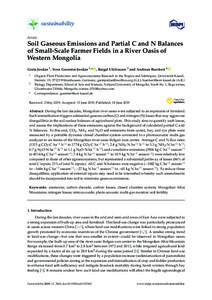| dc.date.accessioned | 2019-09-10T13:24:37Z | |
| dc.date.available | 2019-09-10T13:24:37Z | |
| dc.date.issued | 2019-06-18 | |
| dc.identifier | doi:10.17170/kobra-20190910678 | |
| dc.identifier.uri | http://hdl.handle.net/123456789/11308 | |
| dc.description.sponsorship | Gefördert durch den Publikationsfonds der Universität Kassel | |
| dc.language.iso | eng | |
| dc.rights | Urheberrechtlich geschützt | |
| dc.rights.uri | https://rightsstatements.org/page/InC/1.0/ | |
| dc.subject | ammonia | eng |
| dc.subject | carbon dioxide | eng |
| dc.subject | carbon losses | eng |
| dc.subject | closed chamber system | eng |
| dc.subject | Mongolian Altai Mountains | eng |
| dc.subject | nitrogen losses | eng |
| dc.subject | nitrous oxide | eng |
| dc.subject | photo-acoustic multi-gas monitor | eng |
| dc.subject | soil fertility | eng |
| dc.subject.ddc | 630 | |
| dc.title | Soil Gaseous Emissions and Partial C and N Balances of Small-Scale Farmer Fields in a River Oasis of Western Mongolia | eng |
| dc.type | Aufsatz | |
| dcterms.abstract | During the last decades, Mongolian river oases were subjected to an expansion of farmland. Such intensification triggers substantial gaseous carbon (C) and nitrogen (N) losses that may aggravate disequilibria in the soil surface balances of agricultural plots. This study aims to quantify such losses, and assess the implications of these emissions against the background of calculated partial C and N balances. To this end, CO2, NH3, and N2O soil emissions from carrot, hay, and rye plots were measured by a portable dynamic closed chamber system connected to a photoacoustic multi-gas analyzer in six farms of the Mongolian river oasis Bulgan sum center. Average C and N flux rates (1313 g CO2-C ha−1 h−1 to 1774 g CO2-C ha−1 h−1; 2.4 g NH3-N ha−1 h−1 to 3.3 g NH3-N ha−1 h−1; 0.7 g N2O-N ha−1 h−1 to 1.1 g N2O-N ha−1 h−1) and cumulative emissions (3506 kg C ha−1 season−1 to 4514 kg C ha−1 season−1; 7.4 kg N ha−1 season−1 to 10.9 kg N ha−1 season−1) were relatively low compared to those of other agroecosystems, but represented a substantial pathway of losses (86% of total C inputs; 21% of total N inputs). All C and N balances were negative (−1082 kg C ha−1 season−1 to −1606 kg C ha−1 season−1; −27 kg N ha−1 season−1 to −65 kg N ha−1 season−1). To reduce these disequilibria, application of external inputs may need to be intensified whereby such amendments should be incorporated into soil to minimize gaseous emissions. | eng |
| dcterms.accessRights | open access | |
| dcterms.creator | Jordan, Greta | |
| dcterms.creator | Goenster-Jordan, Sven | |
| dcterms.creator | Ulziisuren, Baigal | |
| dcterms.creator | Buerkert, Andreas | |
| dc.relation.doi | doi:10.3390/su11123362 | |
| dc.type.version | publishedVersion | |
| dcterms.source.identifier | ISSN 2071-1050 | |
| dcterms.source.issue | Issue 12 | |
| dcterms.source.journal | Sustainability | eng |
| dcterms.source.pageinfo | 3362 | |
| dcterms.source.volume | Volume 11 | |

